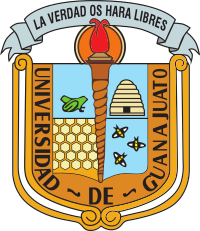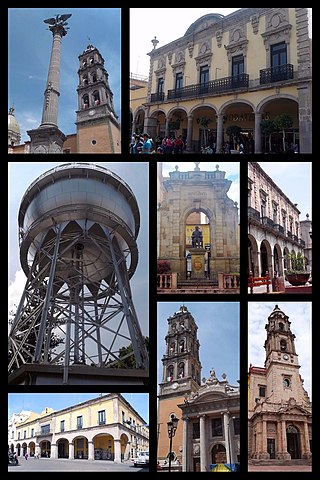
Celaya is a city and its surrounding municipality in the state of Guanajuato, Mexico, located in the southeast quadrant of the state. It is the third most populous city in the state, with a 2005 census population of 310,413. The municipality for which the city serves as municipal seat, had a population of 415,869. The city is located in the geographic center of the municipality, which has an areal extent of 553.1 km2 and includes many smaller outlying communities, the largest of which are San Miguel Octopan, Rincón de Tamayo and San Juan de la Vega.

Guanajuato, officially the Free and Sovereign State of Guanajuato, is one of the 32 states that make up the Federal Entities of Mexico. It is divided into 46 municipalities and its capital city is Guanajuato.

The University of Puerto Rico, Río Piedras Campus is a public land-grant research university in San Juan, Puerto Rico. It is the largest campus in the University of Puerto Rico system in terms of student population and it was Puerto Rico's first public university campus.
Universidad de las Américas Puebla, commonly known as UDLAP, is a Mexican private university located in San Andrés Cholula, near Puebla. The university is known for its programs in Finance, Arts and Humanities, Social sciences, Science and Engineering, and Business and Economics. It is considered to be one of the most prestigious universities in Latin America, having been ranked the best private and single-campus university in Mexico by the newspaper El Universal, as well as being one of the only seven universities in Latin America accredited by the Southern Association of Colleges and Schools. The UDLAP has also been very successful in Mexican collegiate sports; their teams are the Aztecas.
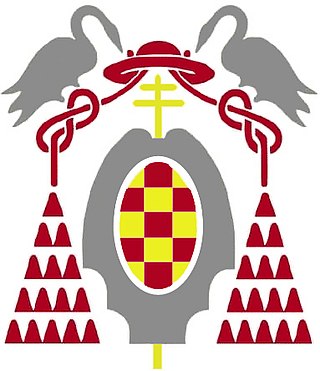
The University of Alcalá is a public university located in Alcalá de Henares, a city 35 km northeast of Madrid in Spain and also the third-largest city of the region. It was founded in 1293 as a Studium Generale for the public, and was refounded in 1977. The University of Alcalá is especially renowned in the Spanish-speaking world for its annual presentation of the highly prestigious Cervantes Prize. The university currently enrolls 28,336 students, 17,252 of whom are studying for undergraduate degrees, who are taught by a teaching staff of 2,608 professors, lecturers and researchers belonging to 24 departments. The administrative tasks are carried out by the university's Administration and Services, comprising approximately 800 people.

The Pontifical Bolivarian University, also referred to as UPB, is a private university in Colombia with its main campus in Medellín, where it was founded in 1936. As of 2023, the university is ranked among the top four universities in Colombia and among the top 30 universities in Latin America by QS World University Rankings. In addition to its main campus in Medellin, the university has campuses in Bogotá, Bucaramanga, Montería and Palmira. As of 2021, the university had an estimated 26,000 students.

The University of Zaragoza, sometimes referred to as Saragossa University is a public university with teaching campuses and research centres spread over the three provinces of Aragon, Spain. Founded in 1542, it is one of the oldest universities in Spain, with a history dating back to the Roman period. Prime Ministers Pascual Madoz, Manuel Azaña, Salustiano de Olózaga and Eusebio Bardají, the Nobel Prize laureate and father of modern neuroscience Santiago Ramón y Cajal, the Catholic saint Josemaría Escrivá and the Cuban national hero Jose Marti studied at this university.

Rey Juan Carlos University is a Spanish public research university located in the southern area of the Community of Madrid (Spain), with five campuses at Móstoles, Alcorcón, Vicálvaro, Aranjuez and Fuenlabrada.
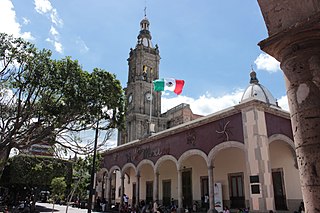
Salamanca is a city and municipality in the Mexican state of Guanajuato.

The Higher Education School of Chemical Engineering and Extractive Industries was founded as part of the National Polytechnic Institute in 1948. It offers undergraduate studies in:

The National University of Equatorial Guinea is a public institution of higher education, being one of the main universities of Equatorial Guinea in Central Africa.
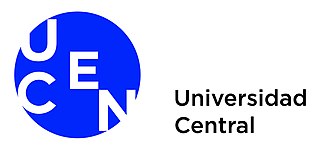
Universidad Central de Chile, abbreviated as UCEN, is the first autonomous private university in Chile, founded in 1982 in Santiago de Chile. It's accredited in the areas of institutional management and undergraduate teaching by the National Accreditation Commission of Chile for a term of four years from December 2017 to December 2021.
The Federal Rural University of the Semi-arid Region, mostly known as UFERSA, in Brazil, was created on August 1, 2005, by Law No 11.155, which transformed the Superior School of Agronomy of Mossoró (ESAM) into a Federal University. ESAM was a municipal Higher Education Institution created on April 18, 1967, by Decree No 03/67 and incorporated to the federal educational system as a Governmental agency under special regime by Decree No 1036, on October 21, 1969. Nowadays, UFERSA has reached a 4 general index course (IGC), according to the Brazilian Ministry of Education.
The Centro de Estudios Científicos y Tecnológicos also known as CECyT is a state Bachillerato Bivalente system in Mexico, belonging to the National Polytechnic Institute (IPN).
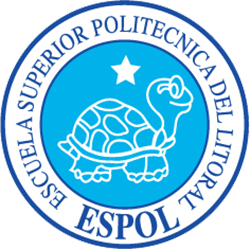
The Escuela Superior Politécnica del Litoral (ESPOL) is a public university located in Guayaquil, Guayas Province in Ecuador. ESPOL has five faculties or schools, fifteen research centers, and several associated centers providing twenty-six undergraduate and ten master's degrees.

The Universidad Peruana de Ciencias Aplicadas (UPC) is a private university in Lima, Peru, founded on January 5, 1994. Currently, it offers 46 career programs categorized in 13 schools.

Universidad Iberoamericana León is a private, Catholic, Jesuit university campus located in Leon, Guanajuato, Mexico, which was founded in 1978 as a campus of Universidad Iberoamericana to extend its reach to the state of Guanajuato and the Bajio region. It is now independently run from the Mexico City campus and it is part of the Jesuit University System, largest university network in the World, with more than 200 universities in 5 continents.
